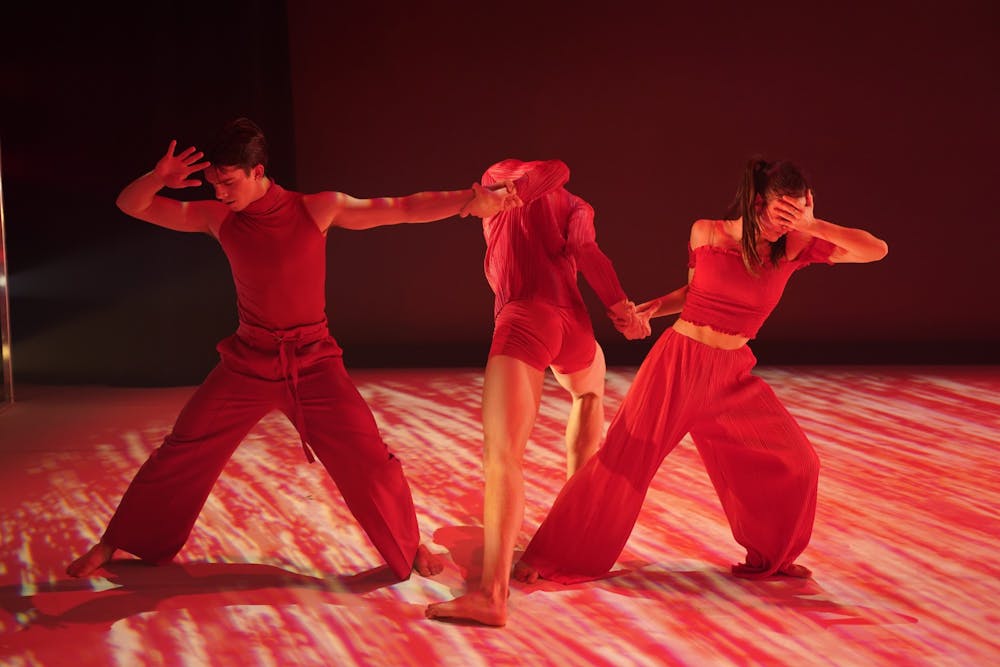Michael Garcia ‘23 is a senior in the Computer Science department and the Program in Dance. He grew up in Pennsylvania, which is where he started dancing, primarily focusing on contemporary dance and ballet. Before starting at Princeton, he did the Bridge Year Program in China, where he began studying hip-hop. At Princeton, Garcia dances and choreographs for diSiac Dance Company. He has trained in New York and Los Angeles, and danced with the American Repertory Ballet this past winter. For his senior dance thesis, Garcia choreographed and performed his work, “Acero,” which explores the different stages of how we process stress in the body.
This interview has been edited slightly for clarity and concision.
The Daily Princetonian: Your certificate performance, “Acero,” explored stress response in the body. What inspired you to tell this story?
Michael Garcia: During the pandemic, I went through something that was pretty life-altering in terms of my personal development. The fallout from that was really severe and it took me a long time to process it all. So, my thesis was largely inspired by that period of my life — not necessarily the initial stressor, but more so how I navigated my own identity and the world as a result of it. I discovered the idea of “stress response” during that period — I would say that really inspired the idea behind the work and then the dance styles fit into that overarching narrative.
DP: In your program notes, you wrote that stress is broken into three stages: Alarm, Resistance, and Exhaustion. What do these three stages mean to you, and how are they intertwined?
MG: During that period in my life, having structure was really helpful for understanding what I was going through. I also explored this idea of processing. There are different levels of processing — there’s physical processing, which is where your body is doing the work, and then there’s mental or intellectual processing. I think “Alarm” is characterized by the fight or flight response. This is where the body kind of takes over and it's purely physical processing.
The next section is “Resistance,” which is essentially where, in your mind, you think that you've moved on past the initial stressor. But the body tells a different story — your cortisol levels and internal hormones remain elevated, but your mind thinks you’ve moved on. So, this is where we move into more intellectual processing, and there’s this disconnect between the mental and physical. For me, it was really about exploring the ways in which you act after the fight or flight response — specifically the ways in which you harm yourself and others, that sort of blind reaction to what initially happened.
The third section is “Exhaustion,” and that's where you've recognized not only that the initial stressor has happened, but also the ways in which you've acted since then. For me, that section was all about reconciliation, guilt, and atonement. Your body and mind are so worn out from everything.
DP: There are many elements here, story-wise and movement-wise. How do they intertwine and how do you balance them?
MG: I would say my first modality of thinking is the narrative — how does this movement actually serve this story I'm trying to tell? Consequently, what is the methodology to convey that narrative? As I mentioned, some of that was pure chaos, some of it was very literal in terms of food, water, and shelter, and then some of it was more emotion-based. For instance, “Resistance” was a hip-hop, jazz funk, street style section. For that, I wasn't working to convey ideas literally. Instead, I was thinking in broader strokes.
We started with the Vogue section, and I chose Vogue as a transition from ballet to hip-hop, because in my mind, Vogue is most similar. It's all about presentation and like ballet, there are constraints that you work within. The way I tried to convey that section choreographically was almost like an unraveling — the movement goes from very structured, sharp, and precise, to very loose and expansive hip hop. “Exhaustion” was almost entirely emotion-based. The movement was very much tied to abstract feelings and ideas. It was more so just trying to choreograph from the heart rather than from the mind.
DP: In creating a performance, there are many important decisions beyond the choreography, like what to wear, what music is playing, what the stage looks like, etc. How did the music add to the structure of your piece?

MG: I played around with the concept of irrationality a lot in my work. I wanted it to feel like it took place over the course of a night, but at the same I also wanted it to feel like it took place over the course of a year. It wanted it to feel like it was set in Princeton, nowhere, on Earth, outer space — all of these things all at once.
“Alarm” was intended to introduce this idea and situate the audience in an unknown time and place. Then, for “Resistance” and “Exhaustion,” I structured it more like a night out. Each song represented a different hour of the night. So, the first song was like 10 p.m., the second was 11 p.m. It went through the hours of the night and then the ending is a 6 a.m. solo. Someone who is involved in the production described each song in “Resistance” as like choosing which drink you're on. So the first song is like the first drink, the second song is the second drink. This added to this idea of unraveling.
DP: Your piece is titled “Acero.” Why did you choose this word? What does that word mean to you?
MG: There are three reasons why I chose “Acero” as the title. The first is to pay homage to the piece’s Spanish music — I felt it was appropriate to use a Spanish name. The second is that “Acero” translates to “steel” in English. To me, that spoke to this idea that the strongest substances are forged during periods of intense change, which essentially captures what I was going for with my thesis in just a sentence. The third reason is a bit more abstract, but I grew up in Pittsburgh, and that's the Steel City. So, in a very indirect way, it was a reference to my roots in the Steel City.
DP: In recent years, discussions around mental health have become more prominent both at Princeton and within the arts community. Why was it important for you to explore this theme?
MG: I came in freshman year and there was a pandemic. Since then, I think one theme that has affected me and my classmates throughout our time at Princeton is mental health. All of us experience mental health struggles and the impacts that Princeton has on mental health to a certain extent. And for me, one unfortunate thing that has really affected me is the fact that four students have committed suicide during my time here — that has really deeply affected how I view Princeton and the ways I have navigated my experience here.
A large part of my own experiences with mental health during my time here have been a result of the University's policies when it comes to academics and being a Princeton student, and as a result, I felt that it was especially important for me — and for those who couldn't be with us today — to share that story and pay homage to those experiences. I dedicated my work to the four students who committed suicide during my time here. I thought about that decision a lot because I wanted it to be respectful.
I also was concerned about the University's response to putting this on the stage and to highlighting these experiences. But, because this has been such a integral part of my experience, and a part of all Princeton students’ experiences to some extent, it was really important that I include this dedication because it is, in many ways, what the work is about, and in many ways, what my Princeton experience has been about as well.
DP: In this piece, you invite audience members to reflect on their own emotional processing. Specifically, what were you hoping to take away from this experience?
MG: I don't think I wanted the audience to take any specific thing away from the experience, as weird as it is to say that. I didn't want them to have answers after watching it — I wanted them to have questions. What does this mean for my own experience? How am I implicated in the narrative that was presented here today? I wanted the audience to question how they have navigated their own lives when it comes to Princeton, when it comes to mental health, and when it comes to a core theme of the work, which was, “How have we harmed myself and others in the ways in which we've all responded to stress and traumatic situations?” I wanted the processing of the work to not be limited to the theater, but to be extended to their own lives and to live on in their memory.
DP: I’m sure that there were points where you were stressed out while creating this piece. In times of stress, how does dance help you process your emotions?
MG: During this period of my life, where it was really challenging, I ended up going to LA for the summer. I was doing an internship remotely, but also taking dance classes. LA, as you may know, is kind of the dance capital of the world — they have the best choreographers, the best teachers, and the best dancers there. I was able to take classes there all summer, and for me, that was a really inspirational and therapeutic experience where, regardless of what was going on in my own life, I could go to dance class and leave all of that at the door, and be fully present in my mind and body, even if it was just for an hour. As a result, I not only rediscovered my love of dance after the pandemic, but it also really repositioned dance as a language of expression and of processing for myself. That was really beautiful after this period of my life. Dance definitely became a way for me to process and express my experiences in an artistic and exciting way.
Kerrie Liang is a head editor for The Prospect and an assistant editor for Podcasts at the ‘Prince.’ She can be reached at kerrie.liang@princeton.edu, or on Instagram at @kerrie.liang.








